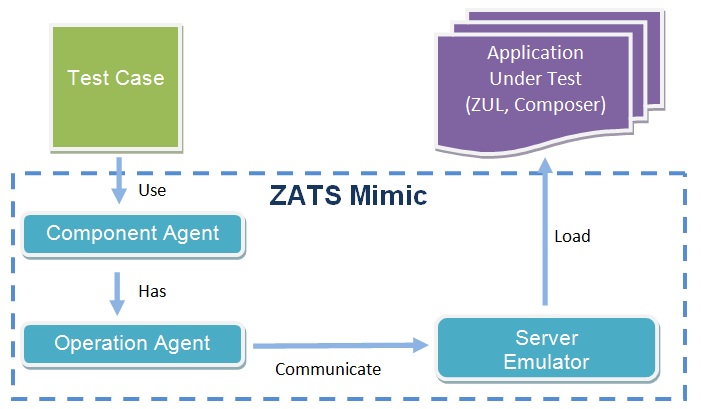ZATS
Overview
ZK Application Test Suite (ZATS) is a collection of tools which can help users test their ZK-based application. This suite has following modules:
ZATS Mimic, a unit-test library that can be used with any well-known unit test framework (e.g. JUnit and TestNG) to test your ZUL without an application server or a browser.
ZATS Mimic enables developers to test their composer without an application server and of course without a browser either. Through this library, testers can mimic user interactions to applications such as clicking or typing to verify composer's (controller layer) data and logic. All they have to do is to write a regular unit test case and use Mimic's utility class to interact components on ZUL and then, run the test case.
No deploying to server, no rendering on browser, the unit test case can be executed in a very short period of time - this is very helpful for frequent unit testing during a agile development process.
The concept is as follows:
Testers write test cases to simulate user action such as clicking or typing with operation agents. Operation agent communicates with server emulator and triggers the composer's event handlers to change the component's status. Testers are able to check component's properties from the component agent to verify the result of user action. It might be a label changing its value or a listbox increasing by one item. All behaviors that reflect on the component's properties can be verified.
Test Case Sample
We have an application to test here. This application only has one label and one button with no other content at first. It has only one function: when a user clicks the button, the label shows "Hello Mimic" as shown in the image below. We are going to verify this behaviour.
ZUL of our simple application
<zk>
<window title="hello" border="normal" width="300px" apply="org.zkoss.zats.example.hello.HelloComposer">
<label />
<button label="Hello" />
</window>
</zk>
Composer of our simple application
public class HelloComposer extends SelectorComposer {
@Wire("label")
Label label;
@Listen("onClick = button")
public void hello(){
label.setValue("Hello Mimic");
}
}
We write the test case with JUnit 4 annotation, please refer to JUnit 4 in 60 seconds.
The following test case will mimic a user clicking the button and verify whether or not the the label's value is "Hello Mimic".
HelloTest.java"
//remove import for brevity
public class HelloTest {
@BeforeClass
public static void init() {
Zats.init("./src/main/webapp");
}
@AfterClass
public static void end() {
Zats.end();
}
@After
public void after() {
Zats.cleanup();
}
@Test
public void test() {
DesktopAgent desktop = Zats.newClient().connect("/hello.zul");
ComponentAgent button = desktop.query("button");
ComponentAgent label = desktop.query("label");
//button.as(ClickAgent.class).click();
button.click();
assertEquals("Hello Mimic", label.as(Label.class).getValue());
}
}
- Before starting a test, we have to call
Zats.init()and pass root directory where ZUL pages are stored as a parameter. Most of the times, it is located in your web application's content root folder. In our example, we use maven default project structure. This method initializes testing environment and starts the server emulator. (line 5)
- Of course, we start the server emulator at
@BeforeClass, we should stop it byZats.end()at@AfterClass. (line 10)
- We should call
Zats.cleanup()to clear desktop before opening another ZUL. (line 15)
- The first statement of a test case is to create a client and connect it to a ZUL page, like a browser visiting a ZUL. The
connect()returns aDesktopAgentand we usually retrieveComponentAgentfrom it to perform user operation. (line 20)
- Before we can mimic a user action to a component, we should retrieve a ComponentAgent. Empowered by selector syntax,
DesktopAgent .query()is a powerful tool to retrieve it. As the ZUL contains only one button, we can query it by component name:query("button")(line 22)
- As we do not have a browser screen to view, we cannot interact with a component by mouse's pointer. To mimic a user action, we have to convert
ComponentAgentto one of the operation agents. The conversion methodas()will check for available operation for the targetComponentAgent. For example, you cannot type something in a Label, If you try to convert it to an unsupported operation agent, you will get an exception. (line 25)
- For convenience,
ComponentAgentprovides shortcut methods for commonly used operations likeclick(); it automatically gets operation agent and calls it for you. (line 26)
- To verify test result, we can also use
ComponentAgent.as()to convert it to a ZK component then get its property by getter methods. (line 27)
Version History
| Version | Date | Content |
|---|---|---|
| 6.0.0 | overview |

